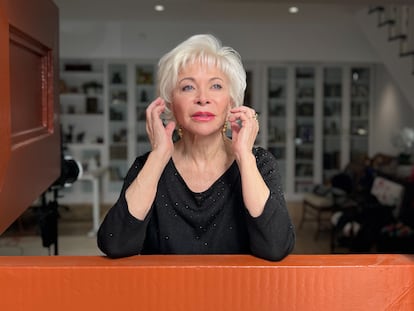Ina’s murder: the young TikToker who flaunted Chile’s narcoculture
The 24-year-old gang boss made boastful and revealing videos in prison about the country’s shadowy drug subculture


Sabrina Durán Montero’s final TikTok video, recorded just before she was fatally shot in broad daylight in Padre Hurtado, (southwest of Santiago, Chile), has over five million views. The 24-year-old influencer is wearing a Tommy Hilfiger T-shirt and gold jewelry while she showcases hair products in the video. After her murder on October 24, the video comments filled up with farewells and well wishes for the young woman who went by “Joakina Gusman” on TikTok, an obvious reference to Joaquín “El Chapo” Guzman, the former Sinaloa Cartel boss. Durán wasn’t just a TikToker — she was also a convicted drug trafficker who spent over a year in jail and was released in May 2023. Durán kept on posting videos behind bars, sharing her urban-reggaeton dances and songs as “The Narco Queen of Peñaflor,” the nickname she earned as the leader of a criminal gang in the Santiago suburb of Peñaflor.
As the youngest of nine siblings and mother to a 10-year-old boy, Ina, as her friends called her, grew up around drugs. Court documents cited by local media reveal her early involvement in the drug business as a young teenager. The Durán case shows how drug trafficking has spread to new areas, affecting a specific segment of society over the past decade. Sociologist Rodrigo Ganter, author of a book on Chile’s transnational narcoculture, says that drugs now “have a major influence on the preferences, aesthetics, role models and aspirations of specific social groups.”
According to Pilar Lizana, a security specialist at Chile’s AthenaLab research center, young people often look up to individuals like Ina, who represent a world of power, quick wealth, stolen luxury cars and guns. “Something is failing in Chile that attracts young people to that kind of life. The rule of law has receded in certain areas, leading to rural terrorism in the south and land seizures in Alto Hospicio. Crime then takes over to fill the void,” said Lizana. “Chileans often blame foreign criminals like the Tren de Aragua, but Ina reminds us that we have our own drug bosses, including women. Her prison videos dancing reggaeton wearing flashy jewelry shows the power she held over government institutions.”
How was the influencer able to upload so many videos from the Women’s Penitentiary Center (CPF) in San Miguel? The proliferation of phones inside prisons has long been a problem for Chile. Prison guards have seized nearly 20,000 mobile phones this year from an inmate population of 49,000. When cases like Ina’s arise, the guards quickly move in and seize the phone. However, when a gang leader is involved, they take pains to conceal the identity of the phone’s owner and blame someone lower in the prison hierarchy. And overcrowded cells housing 15-20 inmates make it difficult to find the phones, much less prove ownership.
Pablo Carvacho, director of Chile’s Research Center for Justice and Society, believes that the Ina’s popularity and apparent impunity can be attributed to the widespread use of social media. He also points out that during the pandemic, many real world activities — including crime — migrated to the online realm. “Drug dealers search for potential buyers in the digital space. It’s not just a cultural representation of crime — there’s a functional aspect to it as well,” said Carvacho. He also questions whether Ina was as powerful as she pretended to be, or whether she created an online persona that the news media amplified. “What’s new is that everything gets recorded nowadays, like the life and death of this young woman. And also how quickly it spreads. We — the general public — get exposed to this information in the most graphic way, and it’s like we’re seeing things we never heard of before.”
Mayor Claudia Pizarro of La Pintana, another Santiago suburb, was the first local authority to speak out against the drug culture. She now has police protection due to the death threats that followed. Pizarro noted that Ina had a 10-year-old child. “La Pintana has the highest rate of teenage motherhood. This could be because young people need a purpose in life, a sense of significance and belonging. Currently, we’re working on establishing a technical training center in our municipality to offer a better path for our youth. Are there any universities or technical training centers in Peñaflor?” she asks, referring to the neighborhood where Ina lived. Peñaflor was once a rural area, but is now part of a sprawling metropolitan area with encroaching crime.
“We understand that the drug culture may seem like an easier path, but it often leads to jail and even death. It’s disheartening that as a government, we have been slow to respond and provide better opportunities,” said Pizarro, who has invested more in sports and cultural programs and facilities than in repaving streets. “It’s easy to criticize me because a patched pothole is glaringly obvious. But a swimming teacher, a volleyball instructor, a theatrical performance — these things can transform the lives of children and youths,” she said resolutely as she leaves the 2023 Pan American Games now underway in Chile. The rugby matches will be played at La Pintana Municipal Stadium.
Ina’s funeral will be held soon in Peñaflor, and has been labeled a high-risk event by the authorities. A special police unit will be deployed to maintain security at the extravagant narcofuneral. Over 1,700 narcofunerals have been held over the last four years in Chile. The three-day memorials always happen in the neighborhood where the deceased criminal lived and the cemetery where he or she is buried. In late September, President Gabriel Boric sent a bill to the National Congress that would limit both the time and place of high-risk funerals that disrupt neighborhood life and put its residents at risk.
Sign up for our weekly newsletter to get more English-language news coverage from EL PAÍS USA Edition
Tu suscripción se está usando en otro dispositivo
¿Quieres añadir otro usuario a tu suscripción?
Si continúas leyendo en este dispositivo, no se podrá leer en el otro.
FlechaTu suscripción se está usando en otro dispositivo y solo puedes acceder a EL PAÍS desde un dispositivo a la vez.
Si quieres compartir tu cuenta, cambia tu suscripción a la modalidad Premium, así podrás añadir otro usuario. Cada uno accederá con su propia cuenta de email, lo que os permitirá personalizar vuestra experiencia en EL PAÍS.
¿Tienes una suscripción de empresa? Accede aquí para contratar más cuentas.
En el caso de no saber quién está usando tu cuenta, te recomendamos cambiar tu contraseña aquí.
Si decides continuar compartiendo tu cuenta, este mensaje se mostrará en tu dispositivo y en el de la otra persona que está usando tu cuenta de forma indefinida, afectando a tu experiencia de lectura. Puedes consultar aquí los términos y condiciones de la suscripción digital.
More information
Archived In
Últimas noticias
Most viewed
- Reinhard Genzel, Nobel laureate in physics: ‘One-minute videos will never give you the truth’
- Oona Chaplin: ‘I told James Cameron that I was living in a treehouse and starting a permaculture project with a friend’
- Pablo Escobar’s hippos: A serious environmental problem, 40 years on
- Charles Dubouloz, mountaineering star, retires at 36 with a farewell tour inspired by Walter Bonatti
- Why we lost the habit of sleeping in two segments and how that changed our sense of time










































